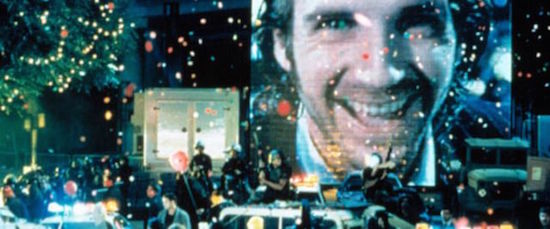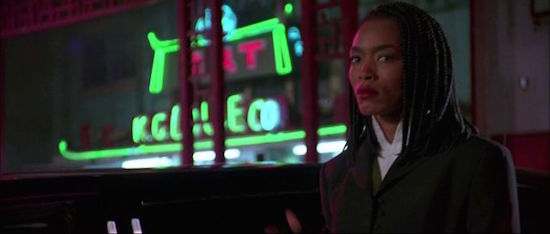All My Stars (28)
By:
July 14, 2016

One in a weekly series in which Joanne McNeil recommends books, films, exhibitions, and more. You can also subscribe to the All My Stars newsletter here.
Kathryn Bigelow is perhaps my most fav of my problematic favs, but I was very surprised last night how well Strange Days holds up. Wow.

I remembered it was about memory and digital recording, surveillance, and a number of other media critical themes; but I forgot how it considers racism and police brutality as well. Bigelow was thinking about Rodney King when she made it. Ralph Fiennes’ rhetoric about the virtual reality-like discs he peddles on the black market, often sounds so much like the vr gurus giving TED talks today. He rationalizes the practice as a highly emotional social engagement, and while he never uses the word “empathy” outright, he is dancing around that concept.
In an interview with Andrew Hultkrans for ArtForum at the film’s release in 1995, Bigelow said, “There’s a tremendous gluttony for images right now; that hunger to experience somebody else’s life instead of our own is so palpable. It’s pure escapism, but it seems fundamental. What else is the appetite for cinema? … The disks deliver pure sensation, but it’s risk-free sensation. You’re allowed to have the experience without the experience’s potential limitations and dangers. Cinema audiences are demanding increasingly more intense experiences, so it’s a necessary extrapolation to make: to break that fourth wall, to go that extra step to the truly experiential.”
She also shares her thoughts on why Los Angeles is the setting of so many bleak postapocalyptic films:
AH: Though the social ills extrapolated in Strange Days are all too real in today’s LA, your version of the city is also an interzone between the LA of the present and the future LA of Ridley Scott’s Blade Runner. What is it about this town that makes it such a primary source text for pre- and postapocalyptic urban environments?
KB: It’s the template, isn’t it? Perhaps because there’s so little history here, there’s a fragile balance, an inherent tension. Also, it’s not a city. There is no center. And in its lack of identity it has a kind of poly-identity: It’s whatever you project onto it, a faceless place that harbors a multitude of identities, all blurred into one. That’s not to say the city isn’t a microcosm for the rest of the country. LA’s culturally polyglot society is critical to the flashpoint world of Strange Days, but I don’t think it’s atypical of the US, it’s just in sharper relief here.
It is a fun film with gruesome elements rather than a overtly campy one, which might be why it’s yet to find a new audience. The lights and costumes and settings are gaudy and eye-catching. Maybe there’s nothing quite as inventive as lightsaber umbrella, but it is a future that feels well lived in. It helps that while the film is quite long (2 1/2 hours), Bigelow still includes quirky contemplative shots like a minute of sleazy Ralph Fiennes with a popsicle in his grimy apartment deciding which alligator print ascot best matches his paisley satin shirt.

The film’s biggest flaw is wasting Angela Bassett. Her character is an unfussy moral center, who is obviously way too good for Fiennes but pines over him anyway. She looks gorgeous in every shot and has one of the best wardrobes of any sci-fi heroine.
Juliette Lewis gets the best line in the film: “You know one of the ways movies are still better than playback? Cause the music comes up, there’s credits and you always know when it’s over.” Then she shouts “It’s OVER!” again at Fiennes, essentially teasing out the contrast between film and virtual reality to reiterate they are never ever getting back together. And I enjoyed her overwrought PJ Harvey covers as nice switch-up from the Tangerine Dream / Vangelis type soundtracks I’ve come to expect from dystopian pictures.
CURATED SERIES at HILOBROW: UNBORED CANON by Josh Glenn | CARPE PHALLUM by Patrick Cates | MS. K by Heather Kasunick | HERE BE MONSTERS by Mister Reusch | DOWNTOWNE by Bradley Peterson | #FX by Michael Lewy | PINNED PANELS by Zack Smith | TANK UP by Tony Leone | OUTBOUND TO MONTEVIDEO by Mimi Lipson | TAKING LIBERTIES by Douglas Wolk | STERANKOISMS by Douglas Wolk | MARVEL vs. MUSEUM by Douglas Wolk | NEVER BEGIN TO SING by Damon Krukowski | WTC WTF by Douglas Wolk | COOLING OFF THE COMMOTION by Chenjerai Kumanyika | THAT’S GREAT MARVEL by Douglas Wolk | LAWS OF THE UNIVERSE by Chris Spurgeon | IMAGINARY FRIENDS by Alexandra Molotkow | UNFLOWN by Jacob Covey | ADEQUATED by Franklin Bruno | QUALITY JOE by Joe Alterio | CHICKEN LIT by Lisa Jane Persky | PINAKOTHEK by Luc Sante | ALL MY STARS by Joanne McNeil | BIGFOOT ISLAND by Michael Lewy | NOT OF THIS EARTH by Michael Lewy | ANIMAL MAGNETISM by Colin Dickey | KEEPERS by Steph Burt | AMERICA OBSCURA by Andrew Hultkrans | HEATHCLIFF, FOR WHY? by Brandi Brown | DAILY DRUMPF by Rick Pinchera | BEDROOM AIRPORT by “Parson Edwards” | INTO THE VOID by Charlie Jane Anders | WE REABSORB & ENLIVEN by Matthew Battles | BRAINIAC by Joshua Glenn | COMICALLY VINTAGE by Comically Vintage | BLDGBLOG by Geoff Manaugh | WINDS OF MAGIC by James Parker | MUSEUM OF FEMORIBILIA by Lynn Peril | ROBOTS + MONSTERS by Joe Alterio | MONSTOBER by Rick Pinchera | POP WITH A SHOTGUN by Devin McKinney | FEEDBACK by Joshua Glenn | 4CP FTW by John Hilgart | ANNOTATED GIF by Kerry Callen | FANCHILD by Adam McGovern | BOOKFUTURISM by James Bridle | NOMADBROW by Erik Davis | SCREEN TIME by Jacob Mikanowski | FALSE MACHINE by Patrick Stuart | 12 DAYS OF SIGNIFICANCE | 12 MORE DAYS OF SIGNIFICANCE | 12 DAYS OF SIGNIFICANCE (AGAIN) | ANOTHER 12 DAYS OF SIGNIFICANCE | UNBORED MANIFESTO by Joshua Glenn and Elizabeth Foy Larsen | H IS FOR HOBO by Joshua Glenn | 4CP FRIDAY by guest curators
